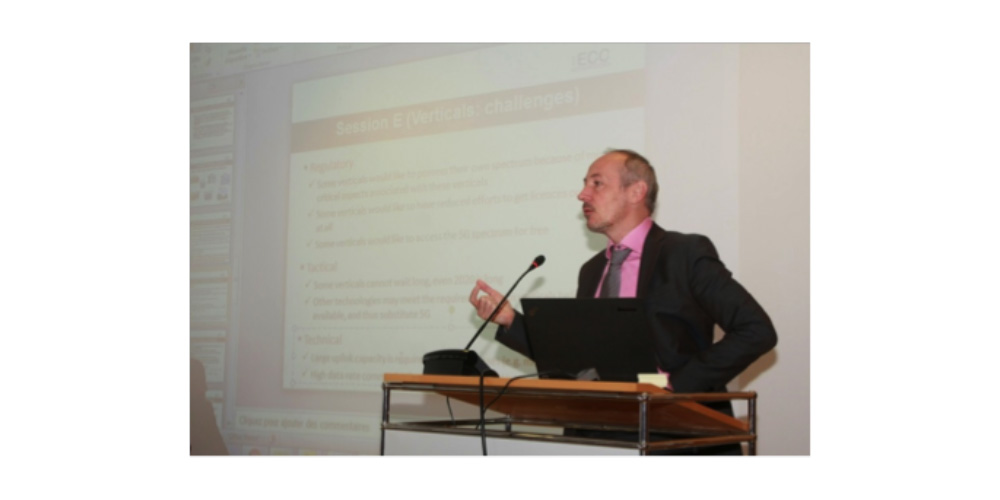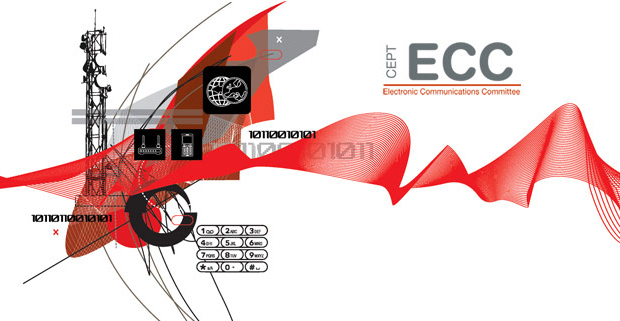CEPT Roadmap - Guiding the way for 5G in Europe
The 43rd ECC Plenary meeting in Prague, 15-18 November 2016, approved a comprehensive list of actions regarding the fifth generation of mobile technology (5G) named "CEPT roadmap for 5G".
It outlines the CEPT's actions and plans for 5G, grouped in four main categories, taking into account the views from all stakeholders expressed during the CEPT Workshop on 5G from 2-4 November 2016 in Mainz (see more here).
1. Identifying harmonised spectrum in Europe for 5G
From all the views expressed across the last months, in the press or during 5G-related events, such as our CEPT workshop, it became clear that harmonisation and timely availability of spectrum are the cornerstones for the success of 5G.
In this respect, ECC agreed to initiate activities towards the development of harmonisation measures on two specific frequency bands:
- 3.4 – 3.8 GHz band: This band is already harmonised within Europe for Mobile/Fixed Communication Networks (MFCN) through ECC Decision(11)06 and provides 400 MHz of contiguous spectrum. Activities are ongoing within the ECC Project Team 1 (ECC PT1) to assess the suitability to 5G of the harmonised technical conditions contained in ECC Decision(11)06. The main target is to set up the appropriate framework to make the 3.4-3.8 GHz the primary band for early 5G developments in Europe. With the view to further promote the harmonisation of the band, and also taking into account the existing licences (for MFCN or for other use) in many CEPT countries, ECC also intends to develop guidelines to help administrations in solutions for defragmenting the 3.4-3.8 GHz band and for developing plans and intended timescale for the future utilisation of this band.
- 24.25-27.5 GHz: Due to the fact that 5G envisages very high data rates, much larger bandwidths than ever before will be required (up to several GHz), which can only be found in higher frequency bands above 24 GHz. To respond to this demand, ECC has identified the band 24.25-27.5 GHz (called the 26 GHz band) for early European harmonisation, as it provides over 3 GHz of contiguous spectrum and more favourable propagation than the higher frequency bands under consideration. As a result, ECC PT1 has recently been tasked to start developing a harmonisation decision setting the conditions for the introduction of 5G in the 26 GHz band. Compatibility with all existing services in the same and adjacent frequency bands should be addressed. Specific attention should be brought to the protection of existing and future earth stations of the Earth Exploration Satellite Service (EESS) and Space Research Service (SRS) in the band 25.5-27 GHz.
2. Preparing for worldwide harmonisation of spectrum above 24 GHz for 5G – WRC-19
The 2019 World Radiocommunication Conference (WRC-19) will take place over four weeks, from 28 October to 22 November 2019, in Geneva. The Conference will address a number of questions within the Radiocommunication sector, and consideration of spectrum for 5G above 24 GHz is expected to feature heavily through the resolution of WRC-19 agenda item 1.13
Consequently, as part of the CEPT Roadmap for 5G, it was important to include steps ahead of WRC-19, when it comes to spectrum above 24 GHz for 5G.
As a consequence of the initiative described in the previous section towards the harmonisation in Europe of the 26 GHz band prior to WRC-19, ECC identified the need to promote it and to use the WRC-19 process to widen its scope to reach worldwide harmonisation.
On the basis of a preliminary assessment carried out at the European level on the set of bands above 24 GHz to be considered at WRC-19, ECC identified, in addition to the 26 GHz band, some potential in the bands 31.8-33.4 GHz (32 GHz band) and 40.5-43.5 GHz bands (42 GHz) for future 5G deployment. Therefore, ECC agrees that CEPT should clearly signal its priorities for the 26, 32 and 42 GHz bands to be studied for WRC-19.
Although not on the list of bands for consideration at WRC-19 for 5G, the band 27.5-29.5 GHz (referred to as the 28 GHz band) has recently been the subject of special attention in the context of 5G due to initiatives outside Europe. In the recent years, ECC has put in place a consolidated regulatory framework to promote broadband satellite communications in this frequency range, in particular to reach mobile platforms (see our article from the October 2016 edition). On the basis of a CEPT proposal, WRC-19 will consider the use of the frequency bands 17.7-19.7 GHz (space-to-Earth) and 27.5-29.5 GHz (Earth-to-space) by earth stations in motion (ESIM) communicating with geostationary space stations in the fixed-satellite service. ECC is therefore supportive of the worldwide harmonisation of the 28 GHz band for broadband satellite communications and for ESIM and does not see any availability for 5G.
On a more general level, and taking into account the experience gained from the previous World Radiocommunication Conferences, ECC identified the need for close cooperation with the other regional organisations on the way to WRC-19. With the view to facilitate consensus at the conference, continuous dialogue between regional groups is therefore crucial.
The success of the WRC-19 activities on spectrum for 5G above 24 GHz will also rely on the involvement from the industry with the ITU-R work and also through the ECC process. In this regard, ECC PT1 is very active, with the participation of the mobile industry, in contributing to ITU-R on the global spectrum needs for 5G and also on the definition of technical characteristics for 5G. This last point is critical since the availability of relevant characteristics is the prerequisite for the development of the necessary sharing and compatibility studies in time for WRC-19.
3. Addressing the requirements from the vertical industries
From a spectrum management point of view, one of the main innovations brought by 5G is its capacity to handle not only broadband mobile communications as the previous generations do, but also to cover the needs from a range of sectors, the so-called 'verticals'.
When it is deployed, 5G technology is expected to become ubiquitous in a number of industries throughout the world, from utilities to railway networks to automotive industries and automation. It is also envisaged for public protection and disaster relief (PPDR) and to support applications in the audio-visual sector. However, it remains unclear to which point the communications will be accommodated through 5G mobile networks, through dedicated network or spectrum, or through hybrid solutions. Today, some bands are designated for PPDR, railway networks, automotive or audio-visual sectors. The future models which will be implemented in a 5G world are still subject to passionate debate.
Due to the broad range of resulting spectrum requirements from each of these sectors, it is quite a challenge, both from technological and regulatory points of view, to determine how to respond to those needs within the overall 5G framework.
Having that in mind, ECC discussed its possible role in this area and agreed to outline a set of topics to consider in relation to verticals.
One of the essential actions to be carried out is the definition of common use cases for requirements of verticals, which would need spectrum harmonisation measures. ECC identified the need to monitor relevant activities within relevant industry groups. In this context, ECC welcomes the emerging initiatives where various industry sectors (e.g. telecoms and automotive) work together to specify use cases and also to assess how verticals' requirements could be addressed in 5G standardisation. ECC also expects to receive, through its close and effective working relationship with ETSI, a range of valuable information and, if appropriate, requests to help in fulfilling the needs of the vertical industries.
Although seen from a different angle in the 5G context, the need for vertical industries to have access to spectrum is obviously not new. ECC has been developing a comprehensive set of spectrum regulations applicable to the various sectors. These regulations will have to be reviewed to assess whether they are "5G compatible". Such considerations are for example expected in the current activities within the ECC Working Group Frequency Management (WG FM) on the review of the regulations for private/ professional land mobile radio systems ('PMR/PAMR') in the 400 MHz range and on the streamlining of the framework applicable to the 57-66 GHz band.

Eric Fournier, ECC Chairman, leading the session gathering the main elements towards the CEPT roadmap during the CEPT workshop on 5G
On top of these general considerations, and having heard the views from industry during the CEPT workshop on 5G, ECC also identified the need to specifically address the following three items related to vertical industries:
- Platform sharing: ECC agreed to investigate, where appropriate, the possibility for verticals to share common platforms. This would for example cover the scenarios where different verticals share a common private network or where verticals are hosted by mobile operator networks or any hybrid model.
- Spectrum redundancy: For critical applications, such as for automated driving, where high quality of service and low latency are required, the idea of spectrum redundancy has recently emerged. This would consist of the identification of two different frequency bands with different propagation characteristics for one single application in order to ensure, through correlation, a better reception. Such a need would obviously have an impact on spectrum management with the consequential increase in spectrum needs and requires further justification.
- Licence exempt regime for critical applications: The frequency bands targeted by some industries are generally licence exempt bands not subject to individual authorisations. Considering the growing needs for the verticals in terms of reliability, for example, the impact of the use of a licence exempt regime for critical vertical applications should be assessed.
4. Investigating other challenges related to spectrum
The workshop on 5G mobile communications gave its attendees much food for thought, and while various themes emerged around the challenges 5G will bring, not everything fell into one of the previous categories. However, some challenges were identified by ECC as deserving special attention as part of the CEPT roadmap.
Spectrum sharing will be an important element to facilitate the requirements of 5G and the development of new technological solutions in higher frequency ranges, such as the more extensive use of MIMO (multiple-input and multiple-output) technique, may provide more opportunities for sharing but also challenges for regulators.
When it comes to higher frequency bands (above 24 GHz), it is anticipated that discussions will arise around the most suitable authorisation regime for 5G. Specifically, the possibility to consider the use of some of these bands for 5G under a general authorisation regime should be investigated as opposed to the individual authorisation which prevails in the currently harmonised bands for MFCN.
With the expected increase in capacity and applications for 5G, the requirements for sufficient backhaul solutions need to be properly handled. In this respect, it is envisaged that the deployment of infrastructure networks in frequency bands such as the 92-105 GHz and 130-175 GHz may provide additional support for 5G communications. Therefore, activities are planned for the development of channel arrangements and associated guidelines for the deployment of fixed networks in these bands.
In addition, as already pointed out in the previous section on verticals, ECC recently initiated a review of the regulations for the 57-66 GHz band. This process should also contribute to provide less restrictive conditions for the potential backhauling solutions for small cells in this band.
Last but not least, although most of the considerations on 5G are given to terrestrial options, there are also some investigations on the possible role that satellite communications can play for the 5G developments. This will be further considered by ECC.

With this CEPT Roadmap, ECC is looking forward to actively guiding the way for 5G to become a reality in Europe. It will be reviewed at each ECC Plenary meeting (three times a year) with an assessment of the related activities.
Eric Fournier, Chairman ECC
Bruno Espinosa, Deputy Director ECO



